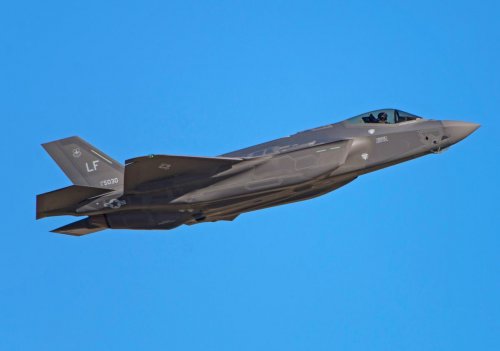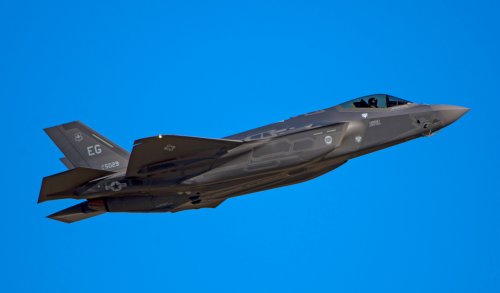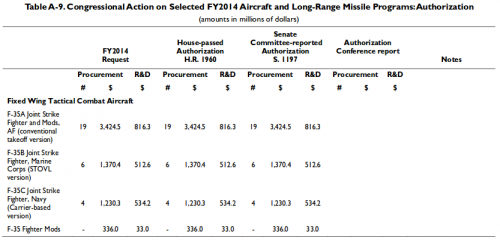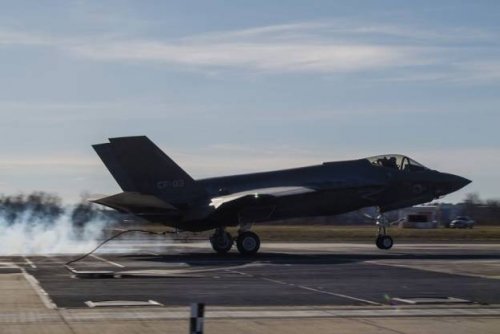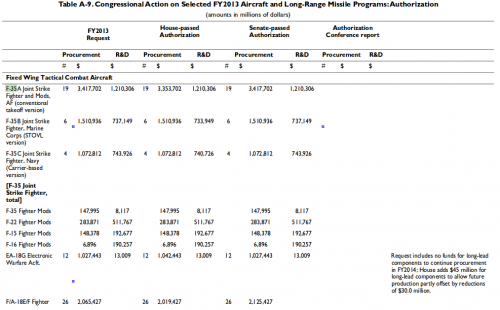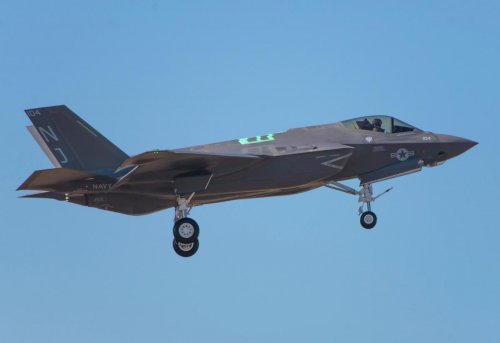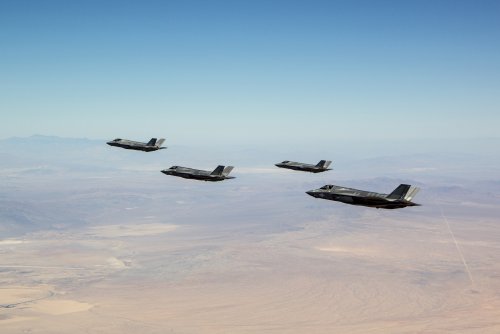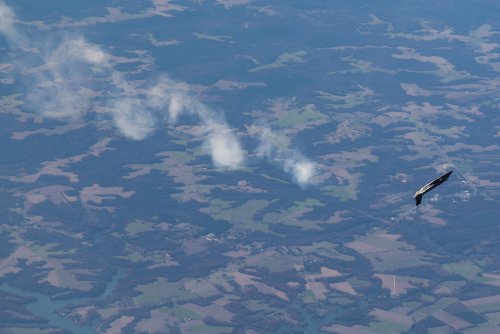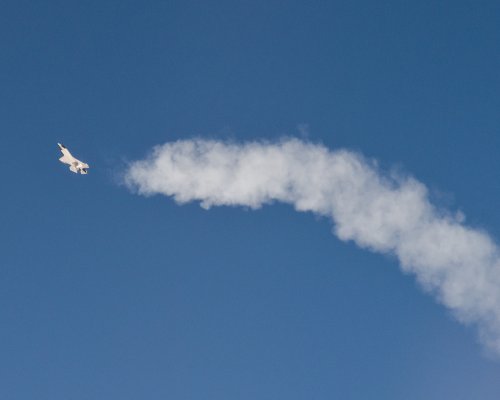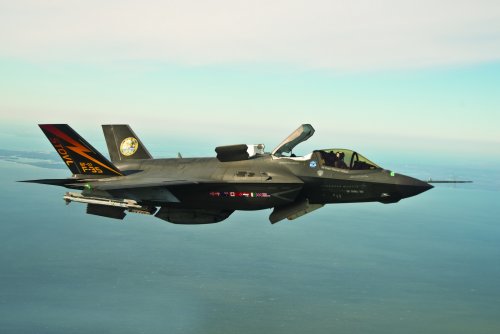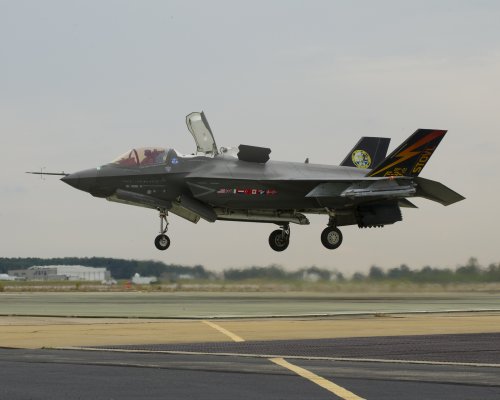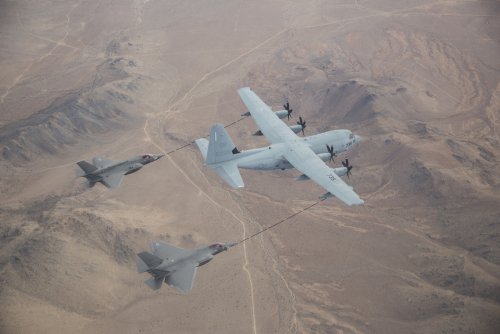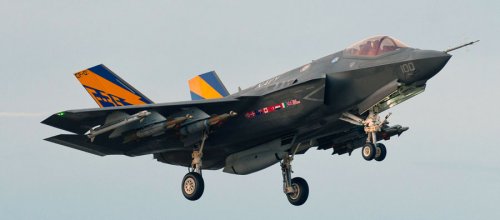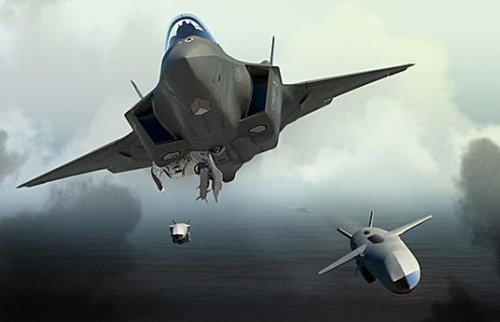S. Korea Joint Chiefs set to back deal for 40 Lockheed F-35s -sources
Fri, Nov 15 2013By Andrea Shalal-Esa
DUBAI, Nov 15 (Reuters) - South Korea's Joint Chiefs of Staff were expected to endorse an "all F-35 buy" of 40 Lockheed Martin Corp F-35 fighter jets and an option for 20 more at a meeting on Nov. 22, two sources familiar with the competition said on Friday.
The Joint Chiefs' decision must be approved by a committee chaired by the South Korean defense minister at a meeting in early December, according to the sources, who declined to be identified because they were not authorized to speak publicly.
A decision by the Joint Chiefs to purchase only F-35s would be a setback for Boeing Co, which had hoped to sell Seoul at least some F-15 fighters as a hedge against delays in the F-35 fighter program, which is completing development.
One source said South Korea was sticking to its initial plan to buy 60 jets to preserve the terms of an industrial offset package that accompanied the Lockheed offer and included a satellite to be launched and placed in orbit.
Any changes in the number of planes ordered would require reopening negotiations with Lockheed, said the source.
The South Korean Air Force has asked for enhanced stealth capability for the fighter jets, a move seen as bolstering the F-35's chances ahead of the Joint Chiefs meeting.
U.S. officials have said Seoul needs to make a decision by the end of the year to ensure delivery of initial F-35s in 2017 since the U.S. government must order advanced materials for the planes in coming weeks. Seoul is said to be looking at buying six F-35 fighter in the ninth batch of early production jets.
The South Korean government voted down a bid by Boeing to supply 60 F-15s in September despite its offer, even though it was the only one of three bids submitted that was under budget. At the time, South Korean officials said they would restart the 8.3 trillion won ($7.8 billion) tender process to get a more advanced, radar-evading jet, but Boeing and its supporters had hoped the government would opt for a split buy of F-35s and F-15s.
"Clearly the U.S will be pleased with this direction," said one of the sources. "By committing to accept early production planes, (South) Korea will help bring down the price for early production aircraft purchased by the United States, Japan and others."
The Eurofighter consortium, which includes BAE Systems Plc , EADS NV and Finmeccanica SpA, also submitted a bid in the South Korean competition.
The sources said there was still a chance the committee that is chaired by the South Korean defense minister could reverse the expected Joint Chiefs decision, but that was seen as unlikely.
You are using an out of date browser. It may not display this or other websites correctly.
You should upgrade or use an alternative browser.
You should upgrade or use an alternative browser.
Lockheed Martin F-35 Lightning II Joint Strike Fighter (JSF)
- Thread starter Triton
- Start date
-
- Tags
- f-35 lockheed martin stealth usa
Published on Nov 20, 2013
Hear from the F-35 pilot and test conductor that executed the F-35C carrier variant's first weapon separation test on Oct. 21, 2013.
http://youtu.be/SvQZFcQ1WMI
Hear from the F-35 pilot and test conductor that executed the F-35C carrier variant's first weapon separation test on Oct. 21, 2013.
http://youtu.be/SvQZFcQ1WMI
S. Korea decides to buy 40 Lockheed F-35s from 2018
By Kim Eun-jung
SEOUL, Nov. 22 (Yonhap) -- South Korea decided Friday to purchase 40 Lockheed Martin's F-35A stealth fighters for four years starting in 2018, with an option to buy 20 more later depending on the security situation and budget, the Joint Chiefs of Staff (JCS) said.
JCS Chairman Choi Yun-hee held a meeting of top commanders to approve the plan to buy the 40 F-35 Block 3s, which are capable of conducting air-to-air and air-to-ground missions with internal carriage and external stations for missiles and bombs. The software configuration is expected to reach the initial operating capability around 2016, according to the U.S. Air Force.
As the F-35 is sold only through the U.S. foreign military sales (FMS) program, the Defense Acquisition Program Administration (DAPA) is expected to purchase the aircraft through a government-to-government deal and without an open bid.
The total budget hasn't been confirmed as the FMS condition requires a foreign government to pay the amount specified by the U.S. government for the F-35s at the time of payment. Seoul had initially assigned 8.3 trillion won (US$7.2 billion) for the past program for 60 jets.
The move comes as the Air Force has asked the government to buy the combat aircraft with a lower radar cross section, one of the key stealth functions, and advanced avionic warfare capabilities.
"The F-35A will be used as a strategic weapon to gain a competitive edge and defeat the enemy in the early stage of war," JCS spokesman Eom Hyo-sik said in a briefing. "The South Korean military will also use the aircraft to effectively deal with provocations."
The purchase plan has been scaled back from the previous one, in which Boeing's F-15 Silent Eagle was the only bid within the budget. The advanced variant of the F-15 was voted down due to its relatively weak stealth capabilities.
For an additional 20 jets, the South Korean government will reconsider the required operational capability and security situations with a goal of deployment between 2023 and 2024, Eom said, giving Boeing and the European Aeronautic Defense and Space Company (EDAS), which participated in the past bidding, an opportunity to secure a contract.
Boeing earlier proposed a mixed purchase of F-15s and F-35s to minimize a security vacuum, while EADS highlighted an offset deal, including the transfer of technology and industrial participation for South Korea's indigenous fighter jet project in synergies between the aircraft procurement and development program.
"The JCS decided to buy 40 jets first to minimize the security vacuum and purchase the remaining 20 after reassessing the required operational capability in accordance with the changing security situations and aerospace technology," Air Force Brig. Gen. Shin Ik-kyun said.
Shin said the stealth jet will play a critical role in destroying major enemy targets as part of the so-called "Kill Chain" defense system, which is designed to detect signs of impending missile attacks and launch pre-emptive strikes.
Lockheed Martin's F-35, which is still under development for the U.S. military, had initially been considered as a favorite, given South Korean Air Force's long pursuit of stealth fighter jets that can pass through North Korea's complex web of radars and given the close relations between the two allies.
However, the past rounds of negotiations that placed high priority on the acquisition price effectively eliminated the F-35, which has been plagued by cost overruns and technical problems.
The move comes as calls have risen to acquire the fifth-generation jet as the Korean Peninsula is encircled by China and Japan, which are at odds with each other over territorial disputes and seek to expand their military power. Russia is preparing to equip its Air Force with stealth jets to counter the U.S. F-35s and F-22s.
Unlike the fierce competition for the past project, industry experts say the one-way bid gives Seoul less room to negotiate other conditions such as a technology transfer or industrial cooperation in connection with the program.
For past biddings, Lockheed, Boeing and EADS had proposed aggressive offset programs to sweeten their bids, ranging from technology transfers to promises of purchasing Korean-made parts.
Industry experts say the F-35 purchase would pose a greater challenge to Seoul when negotiating the technology transfer due to the tight U.S. arms export policy.
"Even if changes have been made to the program and number of jets, we will push for the project by acquiring promises on technology transfer in the fighter development project," a senior ministry official said, without elaborating on the specifics on the negotiations.
During Friday's meeting, the JCS endorsed the indigenous fighter development project, codenamed KF-X, to be included in the mid-term defense budget plan, allowing the defense ministry and the state procurement agency to make a blueprint for system development. The plan needs final approval from the DAPA.
The military aims to complete the development of a fighter jet around 2020 with the goal of deploying it from 2023, according to the officials.
South Korea has been seeking to develop a much larger indigenous fighter jet program with the help of major defense contractors, although that has been delayed due to budget constraints and questions over its feasibility.
The state arms development agency has been working on the concept and designs of the aircraft, and has been waiting for the government's approval to start a full-scale project.
Previous studies by the Korea Development Institute (KDI) showed that the KF-X would cost at least $6 billion for system development alone and would bring about fewer economic benefits than expected, and the total cost for production and maintenance could snowball in the future.
In its 2015-2019 defense plan, the defense ministry estimates the total development cost at about 9.3 trillion won, with plans to allocate the budget to related agencies.
A recent study by the Korea Institute for S&T Evaluation and Planning (KISTEP) pointed out the delayed jet acquisition serves as a setback for the development of the indigenous fighter.
While the Agency for Defense Development (ADD) has been working on the concept and shape of the aircraft, some experts point out that the Air Force has not yet prepared a concrete concept for the aircraft and underestimated its total cost.
Scientists and defense contractors, however, stress the need for government-level efforts to build South Korea's own combat jets with a long-term vision for the aerospace industry.
ejkim@yna.co.kr
(END)
http://www.youtube.com/watch?v=HN5AF3Wlh1g&sns=em
"Gulf buyers eye future purchases of Lockheed's F-35 jet"
By Andrea Shalal-Esa and William Maclean
DUBAI Thu Nov 21, 2013
Source:
http://www.reuters.com/article/2013/11/21/us-airshow-dubai-fighters-idUSBRE9AK14Z20131121
By Andrea Shalal-Esa and William Maclean
DUBAI Thu Nov 21, 2013
Source:
http://www.reuters.com/article/2013/11/21/us-airshow-dubai-fighters-idUSBRE9AK14Z20131121
(Reuters) - Gulf buyers are nearing decisions to buy more current generation fighter jets, but the buzz at the Dubai Airshow was about Lockheed Martin Corp's (LMT.N) radar-evading F-35 fighter - a plane not yet operational and not even on display there.
The U.S. government sent a big delegation to this year's show, eager to reassure Gulf leaders about their continued commitment to the region despite policy differences over Syria and Iran and signs that Egypt is looking at buying Russian weapons after a slowdown in U.S. military aid.
For the first time, U.S. government and industry officials also spoke about the process under way to allow the sale of the Lockheed jet to the Gulf - probably about five years after Israel receives its first F-35 fighter jets in 2016.
U.S. policy guidelines call for Israel to maintain a competitive military edge.
One Gulf source familiar with the region's defense market said the F-35 was generating a degree of excitement even before any U.S. decision to allow its sale to Gulf buyers.
The possibility that the F-35 aircraft might become available could explain why Gulf countries are taking their time with decisions on purchases of other fighters, the source said.
Heidi Grant, deputy assistant secretary of the U.S. Air Force for international programs, said Gulf buyers were focused on buying more fourth-generation jets but were clearly interested in the F-35 - a so-called "fifth-generation" warplane designed to be nearly invisible to enemy radar.
"They're just asking me to monitor it, and when it becomes available let (them) know," Grant told Reuters in an interview. "They understand that we haven't made a policy decision to open up in this region right now."
COMPETITIVE EDGE
Grant said she continued to press for a release of the F-35 technology to the Gulf region, but was also at pains to stick to U.S. military policy.
"I'm constantly telling the partners in the region that as their advocate, I'm pushing (other officials) to look at it," she said, underscoring the growing importance of building coalitions in the region and using common equipment.
The U.S. government always reserves certain capabilities for its own use, but it also wants its partners to be ready to help conduct coalition operation, Grant said.
Boeing Co's (BA.N) F-15 and Lockheed's F-16 were approved for sale to Gulf countries about five years after Israel.
U.S. military sales are handled on a government-to-government basis, and decisions about releasing sensitive technologies are made by a committee that includes the Pentagon, State Department, Commerce Department and other agencies, depending on the technology in question.
U.S. officials say the United Arab Emirates (UAE) has rapidly evolved to become the most capable and reliable U.S. partner in the Gulf region. Washington recently approved the sale of $4 billion worth of munitions to UAE, as well as an advanced missile defense system built by Lockheed.
The $392 billion F-35 JSF, the Pentagon's biggest arms program, has seen a 70 percent increase in costs over initial estimates and repeated schedule delays, but U.S. officials say the program has made progress in recent years. The U.S. Marines Corps says it is on track to start using the plane in mid-2015.
Lockheed is building three models of the F-35 for the U.S. military and eight countries that helped fund its development: Britain, Canada, Norway, Denmark, Australia, Italy, Turkey and the Netherlands.
Israel has ordered 19 jets that will be equipped with Israeli electronic warfare equipment as part of a deal that includes options for up to 75 jets.
Japan has also ordered the plane, and South Korea is expected to announce its plans to buy F-35s on Friday.
"There's demand," Patrick Dewar, executive vice president of Lockheed's international unit, told Reuters. "There have been multiple countries - and there will be more - that are requesting a date certain when F-35 will be released to them, and the U.S. government has that on their to-do list."
"LET'S DELAY IT"
Dewar said the U.S. government had provided publicly available information to potential Gulf buyers but no classified briefs had yet been provided to his knowledge.
He said the F-35 is a multi-role fighter that was designed to replace the F-16, the F/A-18 and many other warplanes.
"Any air force that currently flies those jets has an expectation - and should have an expectation - that in the future at some time, the United States would release the F-35 to replace those jets," Dewar said.
He said Lockheed was working with the U.S. government to ensure its release policy was in synch with the planning process required by each of the governments for big arms deals.
Carrol Chandler, a senior executive with engine maker Pratt & Whitney, told Reuters earlier this week there was strong interest in the plane, but it would likely be several years before exports to the Gulf were approved.
One U.S. source familiar with the world fighter market said countries like the UAE and Saudi Arabia that currently operate several types of fighters were more likely to buy other currently available jets in the interim. But countries with single-fighter fleets like Kuwait could decide to wait for the F-35 to become available, said the source.
Advanced as it is, the F-35 Lightning must contend with competition from European manufacturers and Boeing Co, which tout the benefits of their jets compared with the F-35, and raise questions about the schedule for the Lockheed jet.
French firm Dassault's (AVMD.PA) Rafale jets and the BAE Systems (BAES.L)-backed Eurofighter Typhoon are in a tight race to win a deal for at least 60 new aircraft to replace the UAE's Mirage fleet. UAE is also looking at buying 25 more Lockheed F-16s as well as upgrades for its existing jets.
The Eurofighter, built by Britain's BAE, EADS (EAD.PA) and Italy's Finmeccanica (SIFI.MI), is being marketed by BAE, which is chasing deals in Saudi Arabia, Qatar and Bahrain.
Douglas Barrie of the International Institute for Strategic Studies in London said Lockheed could be trying to stall any European purchase to buy time to complete development of the F-35, and get through the U.S. approval process.
In past competitions "when they looked like they weren't going to win with their current offering ... the strategy process went from 'Let's win this' to 'Let's delay it'," he said.
"The delay arguably was about getting the decision point to where you could put the F-35 on the table and say 'Why don't you buy the Lightning?'"
(Editing by Mark Potter
- Joined
- 6 November 2010
- Messages
- 4,228
- Reaction score
- 3,164
From Bloomberg: F-35 Production Depends on Tests Not Budgets, Carter Says
More at the link.Increased production of Lockheed Martin Corp.’s (LMT) F-35 depends more on how the fighter fares in testing than how deeply the Pentagon budget is cut, Deputy Defense Secretary Ashton Carter said.
“The principle thing that is determining in the next couple of years” whether to ramp up production of the Joint Strike Fighter “is less our budget situation than it is the maturity of the program,” Carter said in an interview.
The comments by Carter, who’s preparing to leave his post as the Pentagon’s No. 2 civilian official on Dec. 4, reflect the Defense Department’s continuing effort to shelter the costliest U.S. weapons system from $500 billion in defense spending cuts over a decade under the budget process called sequestration.
- Joined
- 21 April 2009
- Messages
- 13,168
- Reaction score
- 6,051
- Joined
- 21 April 2009
- Messages
- 13,168
- Reaction score
- 6,051
Burlington, Hill Named First Operational Home for F-35A
Burlington ANGS, Vt., and Hill AFB, Utah, will serve as the first operational homes for the Air Force’s combat-ready F-35 strike fighters, announced USAF officials Tuesday. The decision comes more than three years after the service first announced its preferred initial basing sites for the fifth-generation fighters. Burlington was selected after a lengthy analysis of operational considerations, installation attributes, and economic and environmental factors, according to the Tuesday statement.
Timothy Bridges, deputy assistant secretary of the Air Force for installations, noted that Burlington’s airspace and ranges can support projected F-35A operational training requirements while offering joint training opportunities with F-15Cs from the Massachusetts Air Guard and Canadian CF-18s in Quebec. The Vermont ANG will receive 18 F-35s, which are scheduled to arrive in 2020. The location also has a “mature and highly successful” active associate arrangement with the Air Force for its F-16s, which will transition with the arrival of the F-35. For the Active Duty, Hill’s location near the Utah Test and Training range, provides access to one of the largest and most diverse ranges in the Air Force, Bridges noted. Hill also is home to the F-35 depot. Construction will begin immediately on facilities, and the first of 72 aircraft will arrive at Hill starting in 2015.
Burlington ANGS, Vt., and Hill AFB, Utah, will serve as the first operational homes for the Air Force’s combat-ready F-35 strike fighters, announced USAF officials Tuesday. The decision comes more than three years after the service first announced its preferred initial basing sites for the fifth-generation fighters. Burlington was selected after a lengthy analysis of operational considerations, installation attributes, and economic and environmental factors, according to the Tuesday statement.
Timothy Bridges, deputy assistant secretary of the Air Force for installations, noted that Burlington’s airspace and ranges can support projected F-35A operational training requirements while offering joint training opportunities with F-15Cs from the Massachusetts Air Guard and Canadian CF-18s in Quebec. The Vermont ANG will receive 18 F-35s, which are scheduled to arrive in 2020. The location also has a “mature and highly successful” active associate arrangement with the Air Force for its F-16s, which will transition with the arrival of the F-35. For the Active Duty, Hill’s location near the Utah Test and Training range, provides access to one of the largest and most diverse ranges in the Air Force, Bridges noted. Hill also is home to the F-35 depot. Construction will begin immediately on facilities, and the first of 72 aircraft will arrive at Hill starting in 2015.
Published on Dec 10, 2013
F-35 test pilot Dan Canin answers questions about the F-35 pre-flight checklist, test points, and storage for pilots' personal items. Watch the Test Pilot Tuesday playlist for more Q&A with pilots.
http://youtu.be/vAuovXjzvTA
F-35 test pilot Dan Canin answers questions about the F-35 pre-flight checklist, test points, and storage for pilots' personal items. Watch the Test Pilot Tuesday playlist for more Q&A with pilots.
http://youtu.be/vAuovXjzvTA
Norway authorizes purchase of six more F-35s
3:58am ESTOSLO, Dec 11 (Reuters) - Norway's parliament authorised the government to purchase another six Lockheed Martin Corp F-35 fighter jets for about 4 billion crowns ($654.7 million), the parliament's foreign affairs and defence committee said on Wednesday.
The six jets, to be delivered in 2018, bring the Norwegian order to 16 planes, a small boost for a programme suffering from repeated delays and a 70 percent increase in costs over initial estimates.
Norway plans to buy a total of 52 F-35s by the end of 2024, but purchases for each year have to be separately approved by parliament.
The government expects the total lifetime cost of its F-35 programme at 248 billion crowns, it said earlier.
Lockheed is developing three models of the new radar-evading warplane for the U.S. military and eight countries that helped fund its development: Britain, Canada, Turkey, Italy, Norway, Australia, Denmark and the Netherlands.
Israel and Japan have also placed orders for the jet.
TAI Delivers First F-35 Centre Fuselage to Northrop Grumman
(Source: Turkish Aerospace Industries; issued Dec. 11, 2013)
Turkish Aerospace Industries (TAI) has delivered its first F-35 Lightning II centre fuselage to Northrop Grumman and Lockheed Martin at a ceremony held at TAI's facilities in Ankara, Turkey today.
This is the first F-35 centre fuselage manufactured by TAI as an international manufacturing partner to Northrop Grumman. The centre fuselage will be installed into a U. S. Air Force aircraft at Lockheed Martin’s facilities in Fort Worth, Texas.
“Delivery of the first F-35 center fuselage is a major step by TAI to demonstrate its commitment to adding value to the program,” said Muharrem Dortkasli, President and Chief Executive Officer, TAI. “TAI invested in brand new, state-of-the-art facilities, machinery, equipment and tooling to manufacture the most advanced and complex assembly of the F-35, Fifth-generation fighter aircraft. It is now time to begin delivering world-class TAI center fuselages to the final production line at an increasing rate every year.”
“TAI has a long, proven track record of building exceptional aerospace products. Delivery of this high quality, affordable centre fuselage on time has been another major milestone. TAI will continue utilizing its capability and capacity throughout the life of the programme until 2040s,” Dortkasli added.
“Turkish Aerospace Industries has played an integral part in the development and production of the F-35 for more than a decade,” said Steve O’Bryan, vice president of F-35 Programme Integration and Business Development for Lockheed Martin. “The delivery of the first centre fuselage today marks a key milestone for the program and TAI.”
“This is a great achievement for the Northrop Grumman-TAI team, said Brian Chappel, vice president, F-35 programme, Northrop Grumman Aerospace Systems. “We worked hand-in-hand to manufacture the first centre fuselage, following established processes implemented by Northrop Grumman on our own assembly line in California. Together, we are driving down costs and raising efficiencies to help the F-35 programme meet its affordability goals.”
Once the programme reaches full rate production, TAI will support F-35 final assembly lines in the United States and Italy by shipping one centre fuselage every 10 days. TAI’s centre fuselages will be integrated into the Turkish F-35 aircraft as well as other participating nations’ aircraft.
In addition to building centre fuselages as a Northrop Grumman subcontractor, TAI is the single source for centre fuselage metallic assemblies for F-35A, selected composite components for all F-35 variants, and is one of two sources for composite air inlet ducts for F-35A, and air-to-ground alternate mission pylons for all F-35 variants.
Through participation in the F-35 program, TAI not only contributes to Turkey’s economy, but it will also provide employment for hundreds of engineers and technicians for 20 years.
-ends-
Published on Dec 13, 2013
On Friday, Dec. 13, 2013, Lockheed Martin unveiled the 100th F-35, known as AF-41, at a ceremony for employees, elected officials and customers. AF-41 is a conventional takeoff and landing (CTOL) aircraft, and it will be the first of 144 F-35s delivered to "Fighter Country" at Luke Air Force Base (AFB) in Glendale, Ariz
http://youtu.be/wGgaRaZP_w8
On Friday, Dec. 13, 2013, Lockheed Martin unveiled the 100th F-35, known as AF-41, at a ceremony for employees, elected officials and customers. AF-41 is a conventional takeoff and landing (CTOL) aircraft, and it will be the first of 144 F-35s delivered to "Fighter Country" at Luke Air Force Base (AFB) in Glendale, Ariz
http://youtu.be/wGgaRaZP_w8
Additional Japanese F-35s coming (over and above the 42 already planned) ;D :
Japan to hike mid-term defense spending by 5%
TOKYO —
Japan will raise its defense spending over the next five years by about 5% to 24.6 trillion yen to respond to China’s growing military budget, according to a report in the Nikkei financial daily.
Defense Minister Itsunori Odonera and Finance Minister Taro Aso reached a compromise to free up funds, the Nikkei reported Friday, citing people familiar with the matter.
The defense ministry had sought 24.9 trillion yen but faced resistance from the finance ministry, the paper said, adding that the cabinet is expected to approve the plan on Tuesday.
Japan’s plan to spend more on defense comes as tensions with China have risen over tiny islands in the East China Sea - known as the Senkaku in Japan and the Diaoyu in China.
The spending plan includes an additional purchase of F-35 fighters, made by Lockheed Martin Corp, as well as two more Aegis warships, bringing the total to eight.
Japan is also buying the tilt-rotor Osprey surveillance aircraft, built by Boeing Co and Textron Inc’s Bell Helicopter unit, and drones including Northrop Grumman Corp’s Global Hawk.
Beijing recently announced a new airspace defense zone that includes the skies over the long-disputed islands, raising the ire of its neighbors and the United States.
Japan’s new defense program is an update of a defense posture last reviewed in 2010 under the now-opposition Democratic Party of Japan.
A lot of new equipment purchases in latest 5-year defense plan
December 14, 2013
By KOJI SONODA/ Staff Writer
Japan's new five-year Mid-Term Defense Program includes outlays for 17 new Osprey tiltrotor aircraft and three Global Hawk surveillance drones to help it respond to China's growing presence in the East China Sea.
The plan, revealed Dec. 13, starts in fiscal 2014. It is expected to be approved in a Cabinet meeting on Dec. 17 along with the National Defense Program Guidelines.
The government plans to use the new aircraft to heighten its capabilities to protect remote islands and to monitor China's activities in waters and airspace near the disputed Senkaku Islands.
It also said it will purchase 52 amphibious vehicles for the Ground Self-Defense Force for use in landing operations. The amphibious vehicles will be the same as those used by the U.S. Marine Corps. The plan also calls for reducing the number of GSDF tanks and replacing them with 99 eight-wheeled maneuver combat vehicles that have higher running capabilities than tanks.
Further spending will include 28 F-35 Lightning fighter jets for the Air Self-Defense Force, as well as four new early-warning aircraft and three new air-refueling and transportation aircraft.
Since the government put the Senkaku Islands under state ownership in September 2012, Chinese government's vessels have repeatedly intruded into Japanese territorial waters around the islands, heightening tensions between the two countries.
The Defense Ministry decided it was paramount to establish amphibious troops that will be able to take back islands in the event they are invaded and occupied.
With the introduction of the 17 Ospreys and 52 amphibious vehicles, the ministry believes the SDF will have landing capabilities comparable to those of the U.S. Marine Corps.
The defense plan also calls for bringing the number of GSDF members to 159,000, an increase of 5,000 from the figure of the national defense program guidelines compiled by the Democratic Party of Japan-led government in 2010.
The ministry said it will use the Global Hawk drones to strengthen surveillance capabilities of the military activities undertaken by China and North Korea.
The Global Hawk can fly at the extremely high altitude of 18,000 meters for more than 30 hours. Three Global Hawks are currently deployed by U.S. forces at Andersen Air Force Base in Guam. Their mission is to engage in surveillance activities in the Asia-Pacific region.
The United States also plans to deploy Global Hawk aircraft to Misawa Air Base in northern Japan in 2014.
The Defense Ministry said Japan and the United States will be able to share surveillance information if they are both using the same type of Global Hawk.
The government will also increase the number of Aegis-equipped ships from the current six to eight for the Maritime SDF. The Aegis defense system has the capability to counter ballistic missile attacks. The decision was made with North Korea in mind.
Of the 24.7 trillion yen ($239 billion) to be spent for the Mid-Term Defense Program, 700 billion yen will accrue from cost-cutting. Thus, the total defense spending will be about 24 trillion yen in real terms, an increase from the 23.5 trillion yen earmarked by the DPJ-led government in 2010.
The defense budget for the next fiscal year starting in April 2014 was put at 4.9 trillion yen.
- Joined
- 21 April 2009
- Messages
- 13,168
- Reaction score
- 6,051
Lockheed Martin Completes 100th F-35
Fort Worth, Tex.—Lockheed Martin celebrated the completion of the 100th F-35 strike fighter during a Dec. 13 ceremony at its Fort Worth, Tex., facility. The aircraft, the first training-coded F-35A, will be delivered to the Air Force in the first quarter of 2014. It will be assigned to the 56th Wing at Luke AFB, Ariz., where USAF pilots and foreign F-35A users will learn to employ the aircraft. Training is set to begin in mid-2015 with 17 aircraft, said Gen. Robin Rand, head of Air Education and Training Command, at the ceremony.
Rand said the Air Force will “rethink” the number of simulators used “because the fidelity is so high” allowing them to take on more of the training mission as funding pressure mounts on flying hours. During a briefing with Pentagon reporters the same day, Chief of Staff Gen. Mark Welsh praised the company for the progress the program has made in recent years. “We’re at a point in the F-35 program right now where production rates are going up. Production costs are coming down. I am confident the company knows what it costs to build an airplane now and our program office is fully confident in that,” said Welsh. “Since 2011, the program has met milestones consistently. Now, the 100th airplane coming off the production line is not a minor thing.” (Welsh transcript)
Fort Worth, Tex.—Lockheed Martin celebrated the completion of the 100th F-35 strike fighter during a Dec. 13 ceremony at its Fort Worth, Tex., facility. The aircraft, the first training-coded F-35A, will be delivered to the Air Force in the first quarter of 2014. It will be assigned to the 56th Wing at Luke AFB, Ariz., where USAF pilots and foreign F-35A users will learn to employ the aircraft. Training is set to begin in mid-2015 with 17 aircraft, said Gen. Robin Rand, head of Air Education and Training Command, at the ceremony.
Rand said the Air Force will “rethink” the number of simulators used “because the fidelity is so high” allowing them to take on more of the training mission as funding pressure mounts on flying hours. During a briefing with Pentagon reporters the same day, Chief of Staff Gen. Mark Welsh praised the company for the progress the program has made in recent years. “We’re at a point in the F-35 program right now where production rates are going up. Production costs are coming down. I am confident the company knows what it costs to build an airplane now and our program office is fully confident in that,” said Welsh. “Since 2011, the program has met milestones consistently. Now, the 100th airplane coming off the production line is not a minor thing.” (Welsh transcript)
seruriermarshal
ACCESS: Top Secret
- Joined
- 4 May 2008
- Messages
- 1,177
- Reaction score
- 534
;D
F-35A AF-41 First Flight
Posted 15 December 2013
Lockheed Martin test pilot Al Norman was at the controls for the first flight of F-35A AF-41 (US Air Force serial number 11-5030). The flight occurred on 15 December 2013 with takeoff and landing at NAS Fort Worth JRB, Texas. AF-41 is the 100th F-35 produced and is the first of 144 F-35s scheduled for delivery to Luke AFB, Arizona, beginning in 2014. The US Air Force announced its decision in June 2013 to increase the number of squadrons at Luke AFB to six.
F-35A AF-41 First Flight
Posted 15 December 2013
Lockheed Martin test pilot Al Norman was at the controls for the first flight of F-35A AF-41 (US Air Force serial number 11-5030). The flight occurred on 15 December 2013 with takeoff and landing at NAS Fort Worth JRB, Texas. AF-41 is the 100th F-35 produced and is the first of 144 F-35s scheduled for delivery to Luke AFB, Arizona, beginning in 2014. The US Air Force announced its decision in June 2013 to increase the number of squadrons at Luke AFB to six.
Attachments
“Weight on wheels” for first RAAF F-35
The first F-35A for the RAAF is standing on its on wheels for the first time, a significant milestone for the jet as it moves down the production line of Lockheed Martin’s mile-long assembly plant in Fort Texas, Texas.
The first aircraft, dubbed AU-1 by Lockheed Martin and the future A35-001 with the RAAF, was lifted by an overhead crane from an EMAS – electronic mate and alignment systems – station where its forward and rear fuselage sections were joined to the wing-centre fuselage assembly, to final assembly, where its control surfaces are added and final systems and engine are installed.
AU-1 is due to roll out of the factory in July next year and, alongside sistership AU-2, initially will be based at Luke AFB, Arizona as part of the US Air Force’s F-35 training system being established there.
The December 13 craning of AU-1 from its EMAS station to final assembly was witnessed by a small group of Lockheed Martin and Defence officials, including Air Commodore Cath Roberts, Director General New Air Combat Capability, and Jeff Babione, Lockheed Martin’s vice president and deputy program manager of the F-35 program.
Air Commodore Roberts was already in Fort Worth for other F-35 business that happened to coincide with the “weight on wheels” milestone.
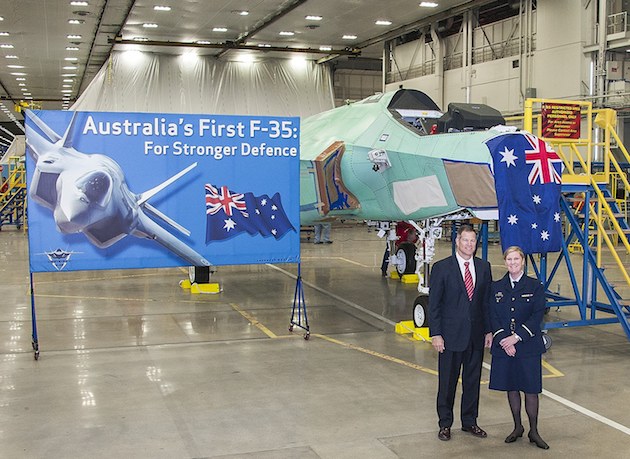
seruriermarshal
ACCESS: Top Secret
- Joined
- 4 May 2008
- Messages
- 1,177
- Reaction score
- 534
;D
F-35A AF-40 First Flight
Lockheed Martin test pilot Al Norman was at the controls for the first flight of F-35A AF-40 (US Air Force serial number 11-5029). The flight occurred on 16 December 2013 with takeoff and landing at NAS Fort Worth JRB, Texas.
F-35A AF-40 First Flight
Lockheed Martin test pilot Al Norman was at the controls for the first flight of F-35A AF-40 (US Air Force serial number 11-5029). The flight occurred on 16 December 2013 with takeoff and landing at NAS Fort Worth JRB, Texas.
Attachments
Published on Dec 20, 2013
An F-35 Lightning II successfully employs a Guided Bomb Unit-32 (GBU-32) Joint Direct Attack Munition (JDAM) weapon from the internal weapons bay against a fixed ground test target on Dec. 6, completing a successful flight test and verification year for weapons integration.
http://youtu.be/xaXQX08lpn4
An F-35 Lightning II successfully employs a Guided Bomb Unit-32 (GBU-32) Joint Direct Attack Munition (JDAM) weapon from the internal weapons bay against a fixed ground test target on Dec. 6, completing a successful flight test and verification year for weapons integration.
http://youtu.be/xaXQX08lpn4
- Joined
- 6 November 2010
- Messages
- 4,228
- Reaction score
- 3,164
From FY2014 Authorization and Appropriations, page 82: http://www.fas.org/sgp/crs/natsec/R43323.pdf
Procurement cost per aircraft.
F-35A:
$ 3,424.5 million for 19 aircraft ------------ $ 180.23 million per aircraft
F-35B:
$ 1,370.4 million for 6 aircraft ------------ $ 228.40 million per aircraft
F-35C:
$ 1,230.3 million for 4 aircraft ------------ $ 307.57 million per aircraft
Procurement cost per aircraft.
F-35A:
$ 3,424.5 million for 19 aircraft ------------ $ 180.23 million per aircraft
F-35B:
$ 1,370.4 million for 6 aircraft ------------ $ 228.40 million per aircraft
F-35C:
$ 1,230.3 million for 4 aircraft ------------ $ 307.57 million per aircraft
Attachments
seruriermarshal
ACCESS: Top Secret
- Joined
- 4 May 2008
- Messages
- 1,177
- Reaction score
- 534
Navy’s F-35 Starts New Tailhook Tests
By: Dave Majumdar
Monday, December 23, 2013
Navy F-35C test plane CF-3 successfully catches a wire during testing at Naval Air Station Patuxent River, Md. Lockheed Martin Photo
Navy F-35C test plane CF-3 successfully catches a wire during testing at Naval Air Station Patuxent River, Md. Lockheed Martin Photo
The Naval Air Systems Command (NAVAIR) has begun testing a new carrier arresting hook for the Navy’s version of the Lockheed Martin F-35 Lighting II Joint Strike Fighter at Naval Air Station Patuxent River, Md.
Aircraft CF-3, which is the first F-35C fitted with a production tailhook, caught an arresting wire at a shore-based test rig on Dec. 19 at the Navy’s primary flight test center according to Naval Air Systems Command. The aircraft was flow by Lt. Cmdr. Tony Wilson.
Testing will eventually move to Naval Air Engineering Station Lakehurst in New Jersey in January 2014 for additional testing with a shore-based arresting gear. Fly-in testing is required to verify that the F-35C will be able to consistently catch an arresting wire.
After the aircraft demonstrates that it can catch a wire on land, the F-35C will have to be tested at sea. Arrested recoveries at sea should take place onboard the USS Nimitz (CVN-68) in the first part of 2014 according to Lockheed officials. However, while the current plan calls for the F-35 to perform its sea-trials onboard the Nimitz, it could be another ship depending on the availability of carriers at the time.
Demonstrating that the F-35C can recover onboard a carrier is critical for a naval aircraft. The tailhook has been a vexing problem on the F-35C variant when it was discovered in 2012 that the hook could not reliably engage an arresting wire.
Lockheed and the Joint Strike Fighter program office ultimately traced the problem back to the shape of the hook and a faulty wire dynamics model supplied by the Naval Air Systems Command. The solution was to reshape the hook point and adjust the system’s hold-down damper, which helps prevent the hook from bouncing around upon touchdown.
The Department of the Navy is set to acquire a total of 340 F-35Cs–260 of which would serve with the Navy while a further 80 would be allocated to the US Marine Corps. The Navy expects the F-35C to become operational in late 2018 or early 2019 with the full Block 3F capability.
http://news.usni.org/2013/12/23/navys-f-35-starts-new-tailhook-tests
By: Dave Majumdar
Monday, December 23, 2013
Navy F-35C test plane CF-3 successfully catches a wire during testing at Naval Air Station Patuxent River, Md. Lockheed Martin Photo
Navy F-35C test plane CF-3 successfully catches a wire during testing at Naval Air Station Patuxent River, Md. Lockheed Martin Photo
The Naval Air Systems Command (NAVAIR) has begun testing a new carrier arresting hook for the Navy’s version of the Lockheed Martin F-35 Lighting II Joint Strike Fighter at Naval Air Station Patuxent River, Md.
Aircraft CF-3, which is the first F-35C fitted with a production tailhook, caught an arresting wire at a shore-based test rig on Dec. 19 at the Navy’s primary flight test center according to Naval Air Systems Command. The aircraft was flow by Lt. Cmdr. Tony Wilson.
Testing will eventually move to Naval Air Engineering Station Lakehurst in New Jersey in January 2014 for additional testing with a shore-based arresting gear. Fly-in testing is required to verify that the F-35C will be able to consistently catch an arresting wire.
After the aircraft demonstrates that it can catch a wire on land, the F-35C will have to be tested at sea. Arrested recoveries at sea should take place onboard the USS Nimitz (CVN-68) in the first part of 2014 according to Lockheed officials. However, while the current plan calls for the F-35 to perform its sea-trials onboard the Nimitz, it could be another ship depending on the availability of carriers at the time.
Demonstrating that the F-35C can recover onboard a carrier is critical for a naval aircraft. The tailhook has been a vexing problem on the F-35C variant when it was discovered in 2012 that the hook could not reliably engage an arresting wire.
Lockheed and the Joint Strike Fighter program office ultimately traced the problem back to the shape of the hook and a faulty wire dynamics model supplied by the Naval Air Systems Command. The solution was to reshape the hook point and adjust the system’s hold-down damper, which helps prevent the hook from bouncing around upon touchdown.
The Department of the Navy is set to acquire a total of 340 F-35Cs–260 of which would serve with the Navy while a further 80 would be allocated to the US Marine Corps. The Navy expects the F-35C to become operational in late 2018 or early 2019 with the full Block 3F capability.
http://news.usni.org/2013/12/23/navys-f-35-starts-new-tailhook-tests
Attachments
- Joined
- 6 November 2010
- Messages
- 4,228
- Reaction score
- 3,164
A comparison of this year's Authorization and Appropriations with data from a year ago:
F-35A:
$ 3,417.702 million for 19 aircraft ------------ $ 179.88 million per aircraft
F-35B:
$ 1,510.936 million for 6 aircraft ------------ $ 251.82 million per aircraft
F-35C:
$ 1,027.443 million for 4 aircraft ------------ $ 256.86 million per aircraft
Cost per F-35A virtually the same, cost per F-35B some $ 28 million down, cost per F-35C some $51 million up.
From FY2013 Authorization and Appropriations, page 72: http://www.fas.org/sgp/crs/natsec/R42607.pdfArjen said:From FY2014 Authorization and Appropriations, page 82: http://www.fas.org/sgp/crs/natsec/R43323.pdf
Procurement cost per aircraft.
F-35A:
$ 3,424.5 million for 19 aircraft ------------ $ 180.23 million per aircraft
F-35B:
$ 1,370.4 million for 6 aircraft ------------ $ 228.40 million per aircraft
F-35C:
$ 1,230.3 million for 4 aircraft ------------ $ 307.57 million per aircraft
F-35A:
$ 3,417.702 million for 19 aircraft ------------ $ 179.88 million per aircraft
F-35B:
$ 1,510.936 million for 6 aircraft ------------ $ 251.82 million per aircraft
F-35C:
$ 1,027.443 million for 4 aircraft ------------ $ 256.86 million per aircraft
Cost per F-35A virtually the same, cost per F-35B some $ 28 million down, cost per F-35C some $51 million up.
Attachments
- Joined
- 6 November 2010
- Messages
- 4,228
- Reaction score
- 3,164
From Defensetech.org: Experts to Study F-35 Software Delays
More at the link.The U.S. Defense Department’s top weapons buyer is assembling a team of independent experts to study the F-35 fighter jet’s software development delays.
Frank Kendall, the Pentagon’s undersecretary of defense for acquisition, technology and logistics, was ordered to put together a group to study the issue and submit a report to Congress by March 3 as part of 2014 National Defense Authorization Act, which sets policy goals and spending targets for the fiscal year that began Oct. 1.
President Barack Obama signed the legislation into law today while vacationing with his family in Hawaii.
[...]
- Joined
- 9 October 2009
- Messages
- 19,940
- Reaction score
- 10,449
Reuters: Exclusive: U.S. waived laws to keep F-35 on track with China-made parts
(Reuters) - The Pentagon repeatedly waived laws banning Chinese-built components on U.S. weapons in order to keep the $392 billion Lockheed Martin Corp F-35 fighter program on track in 2012 and 2013, even as U.S. officials were voicing concern about China's espionage and military buildup.
According to Pentagon documents reviewed by Reuters, chief U.S. arms buyer Frank Kendall allowed two F-35 suppliers, Northrop Grumman Corp and Honeywell International Inc, to use Chinese magnets for the new warplane's radar system, landing gears and other hardware. Without the waivers, both companies could have faced sanctions for violating federal law and the F-35 program could have faced further delays.
"It was a pretty big deal and an unusual situation because there's a prohibition on doing defense work in China, even if it's inadvertent," said Frank Kenlon, who recently retired as a senior Pentagon procurement official and now teaches at American University. "I'd never seen this happen before."
The Government Accountability Office, the investigative arm of Congress, is examining three such cases involving the F-35, the U.S. military's next generation fighter, the documents show.
The GAO report, due March 1, was ordered by U.S. lawmakers, who say they are concerned that Americans firms are being shut out of the specialty metals market, and that a U.S. weapon system may become dependent on parts made by a potential future adversary.
The waivers apply to inexpensive parts, including $2 magnets, installed on 115 F-35 test, training and production aircraft, the last of which are due to be delivered in May 2014. Lawmakers noted that several U.S. companies make similar magnets.
Kendall said the waivers were needed to keep production, testing and training of the Pentagon's newest warplane on track; avert millions of dollars in retrofit costs; and prevent delays in the Marine Corps' plan to start using the jets in combat from mid-2015, according to the documents. In one case, it would cost $10.8 million and take about 25,000 man-hours to remove the Chinese-made magnets and replace them with American ones, the documents indicate.
Lockheed is developing the F-35, the Pentagon's costliest arms program, for the United States and eight countries that helped fund its development: Britain, Canada, Australia, Italy, Norway, Turkey, Denmark and the Netherlands. Israel and Japan have also placed orders for the jet.
The program is already years behind schedule and 70 percent over initial cost estimates. At the time Kendall was granting the waivers, officials were acutely worried that further delays and cost increases would erode the foreign orders needed to drive down the future cost of each warplane.
In the documents, Kendall underscored the importance of the F-35 program to ensure continued U.S. military superiority and counter potential emerging threats from nations developing their own stealth fighter jets, including Russia and China.
He said additional delays would force the United States and its allies to keep its legacy fighters flying longer, which would result in higher maintenance costs. It would also leave them with older jets, which Kendall said "cannot match the offensive and defensive capabilities provided by F-35."
The Pentagon first disclosed problems with non-U.S. magnets in a little-noticed written statement to Congress in the spring of 2013. But the statement did not name companies involved and did not disclose that some of the parts came from China.
Officials at Northrop, Honeywell and Lockheed declined to comment on the issue, referring queries to the Pentagon.
Joe DellaVedova, spokesman for the F-35 Joint Program Office (JPO) at the Pentagon, said the office was committed to ensuring that federal defense acquisition laws were strictly followed.
"There was never any risk of technology transfer or other security breach associated with these manufacturing compliance issues," he said. "The JPO is working with industry to put in place long-term solutions to avoid the need for future waivers."
In his statement to Congress, Kendall said he took the matter "extremely seriously" and said Lockheed was told to take aggressive steps to identify any further cases, and correct its compliance process.
[snip]
- Joined
- 9 October 2009
- Messages
- 19,940
- Reaction score
- 10,449
http://defensetech.org/2013/12/26/experts-to-study-f-35-software-delays/
- Joined
- 6 November 2010
- Messages
- 4,228
- Reaction score
- 3,164
Possibly related to Congress ordering the Pentagon to present an F-35 Software plan:Grey Havoc said:
http://defensetech.org/2013/05/24/congress-orders-f-35-software-plan/#more-20430
<edit>Congress orders F-35 Software Plan
by Kris Osborn on May 24, 2013
Congress ordered the Pentagon to establish an independent team consisting of subject matter experts to review the development of software for the Joint Strike Fighter program.
The House Armed Services Tactical Air and Land Forces Subcommittee asked the Pentagon to submit a report by March 3, 2014 as part of the committee’s markup of the 2014 defense budget. The F-35 software program has served as one of the largest challenges for program engineers to keep on schedule.
[...]
Congress orders Pentagon to establish expert team on F-35 software on May 24, 2013.
President signs appropriate legislation into law on December 26, 2013.
That took seven months.
Two months left to submit the report.
jsport
what do you know about surfing Major? you're from-
- Joined
- 27 July 2011
- Messages
- 6,565
- Reaction score
- 3,912
reason why as mentioned on the thread the "Future Airborne Capability Environment (FACE)" remains a primary DoD concern...
as well as another reason for even more drastic reform than is currently occuring..
as well as another reason for even more drastic reform than is currently occuring..
seruriermarshal
ACCESS: Top Secret
- Joined
- 4 May 2008
- Messages
- 1,177
- Reaction score
- 534
seruriermarshal
ACCESS: Top Secret
- Joined
- 4 May 2008
- Messages
- 1,177
- Reaction score
- 534
seruriermarshal
ACCESS: Top Secret
- Joined
- 4 May 2008
- Messages
- 1,177
- Reaction score
- 534
seruriermarshal
ACCESS: Top Secret
- Joined
- 4 May 2008
- Messages
- 1,177
- Reaction score
- 534
seruriermarshal
ACCESS: Top Secret
- Joined
- 4 May 2008
- Messages
- 1,177
- Reaction score
- 534
Published on Jan 13, 2014
Recap of the U.S. Navy's F-35C Rollout Ceremony at Eglin Air Force Base, Fla., Oct. 1, 2013. Eglin is home to the F-35 Integrated Training Center, where the Navy's VFA-101 pilots and maintainers train with the Air Force, Marines and International partners.
http://youtu.be/Qbo3jPFq58Q
Recap of the U.S. Navy's F-35C Rollout Ceremony at Eglin Air Force Base, Fla., Oct. 1, 2013. Eglin is home to the F-35 Integrated Training Center, where the Navy's VFA-101 pilots and maintainers train with the Air Force, Marines and International partners.
http://youtu.be/Qbo3jPFq58Q
seruriermarshal
ACCESS: Top Secret
- Joined
- 4 May 2008
- Messages
- 1,177
- Reaction score
- 534
"KONGSBERG signs contract with the Norwegian Armed Forces for bridging-phase leading to phase three development of JSM"
Source:
http://www.kongsberg.com/en/kog/news/2013/november/phase-three-jsm-contact-signed/
Source:
http://www.kongsberg.com/en/kog/news/2013/november/phase-three-jsm-contact-signed/
29.11.2013
KONGSBERG has today signed a bridging-phase contract leading to phase 3 with Norwegian Defence Logistics Organization (NDLO) for further development of the JSM (Joint Strike Missile). The contract is valued at NOK 480 million.
The JSM development phase 2 has been finalized and to ensure competence and progress between JSM phase 2 and phase 3, the Norwegian Armed Forces have signed a bridging phase contract prior to parliamentary proceedings and approval of the entire JSM development phase 3.
- The international F-35 user consortium, with the USA as the largest, is showing great interest in the JSM. Therefore we are very pleased with parliamentary support of the development and that the Norwegian government is facilitating further development through all phases, says Walter Qvam, CEO of the Kongsberg Group.
In phase 2 of the project the missile underwent detailed design and a successful integration check for the F-35 as well as for the F-16 and the F-18. In phase three the missile will be completed and ready for serial production, and there will also be produced several units that will be tested from fighter jets in several practical exercises. The JSM is the only long-range sea and land-target missile that can be carried internally in the F-35 and thus ensuring the aircrafts low-signature (stealth) capabilities. After a successful phase 3 KONGSBERG will be ready to receive orders and start serial production.
- Through phase 1 and 2 KONGSBERG tied links with several Norwegian subcontractors qualifying them for phase 3 and serial production. In phase 3 we will engage even more suppliers related to the new tasks. In future full-scale production the JSM project will provide more than 450 jobs in KONGSBERG and provide significant assignments to more than 100 subcontractors for several decades, says Harald Ånnestad, CEO of Kongsberg Defence Systems.
Attachments
"Former Defense Contractor Indicted in Stolen F-35 Documents Case"
Jan. 21, 2014 - 03:45AM |
By AARON MEHTA
Source:
http://www.defensenews.com/article/20140121/DEFREG02/301210029/Former-Defense-Contractor-Indicted-Stolen-F-35-Documents-Case
Jan. 21, 2014 - 03:45AM |
By AARON MEHTA
Source:
http://www.defensenews.com/article/20140121/DEFREG02/301210029/Former-Defense-Contractor-Indicted-Stolen-F-35-Documents-Case
WASHINGTON — A federal grand jury indicted a former Connecticut man who attempted to ship boxes of stolen information on the F-35 Joint Strike Fighter to Iran.
Mozaffar Khazaee is charged with two counts of interstate transportation of stolen property. The 59-year-old former resident of Bridgeport, Conn., faces a maximum of 10 years in prison and a fine of up to $250,000 for each count.
Khazaee was arrested Jan. 9 at Newark International Airport in New Jersey as he prepared to board the first leg of a flight to Iran. A naturalized American citizen since 1991, the Iranian-born Khazaee was identified in media reports as a former employee of Pratt & Whitney, the engine manufacturer for the F-35.
According to a US government affidavit, federal agents began investigating Khazaee in November when he attempted to send a shipment from Connecticut to the Iranian city of Hamadan. When agents inspected the shipment, they found “numerous boxes of documents consisting of sensitive technical manuals, specification sheets, and other proprietary material for the F-35.
Overall, the shipment included thousands of pages of documents, including diagrams and blueprints of the high-tech fighter jet’s engine. Some of the information was marked as being ITAR- and export-controlled information.
Those documents came from three companies, according to the affidavit; although the government identifies them only as companies A, B and C, a spokesman for Pratt confirmed they are one of the firms involved.
No arraignment date has been set and the indictment does not indicate the end of the investigation into Khazaee’s actions.
A Department of Justice press release notes that the case is “being investigated by Homeland Security Investigations in New Haven and Los Angeles, the New Haven Division of the Federal Bureau of Investigation, the Defense Criminal Investigative Service in New Haven, the U.S. Customs and Border Protection Service in Los Angeles, the U.S. Air Force’s Office of Special Investigations in Los Angeles and Boston, and the Department of Commerce’s Boston Office of Export Enforcement.”
- Joined
- 29 July 2009
- Messages
- 1,527
- Reaction score
- 1,541
Has there been any progress on the two seat "Wild Weasel" variant that the Israelis are requesting of Lockheed? Israel defense says recently that the F-35 will be the back bone of Israel's air defense.
"UK orders near for F-35 'stealth’ jet
Demand for new F-35 fighter jet of vital importance to UK manufacturers, with more than 500 British companies working on the project."
by Alistair Osborne
12:44AM GMT 20 Jan 2014
Source:
http://www.telegraph.co.uk/finance/newsbysector/industry/defence/10583321/UK-orders-near-for-F-35-stealth-jet.html
Demand for new F-35 fighter jet of vital importance to UK manufacturers, with more than 500 British companies working on the project."
by Alistair Osborne
12:44AM GMT 20 Jan 2014
Source:
http://www.telegraph.co.uk/finance/newsbysector/industry/defence/10583321/UK-orders-near-for-F-35-stealth-jet.html
Britain's Ministry of Defence is close to placing its first major tranche of orders for the F-35 fighter jet, with an award for about 14 of the “stealth” warplanes due in the next few weeks.
The orders for the new plane, being built in an international project led by US defence giant Lockheed Martin, will signal the increasing role of the British military in the controversial F-35 programme.
But the aircraft is also of vital importance to UK manufacturing companies, with more than 500 British companies, led by the likes of BAE Systems and Rolls-Royce, working on the project.
As the only top-tier international partner, Britain is building 15pc of every jet in a project supporting 25,000 jobs. At peak production, the programme is expected to be worth £1bn a year to British industry. Stephen Ball, Lockheed Martin UK chief executive, said: “The economic story of the F-35 is massive for the next 20 years.”
Costing as much as $1.5 trillion (£910bn) on some estimates, the F-35 project is the most expensive Pentagon defence programme in history, envisaging the construction of more than 3,000 jets.
"F-35 Pilots Will Begin Flying Improved 'Gen 3' Helmet"
by Bill Carey
January 21, 2014, 3:35 PM
Source:
http://www.ainonline.com/aviation-news/2014-01-21/f-35-pilots-will-begin-flying-improved-gen-3-helmet
by Bill Carey
January 21, 2014, 3:35 PM
Source:
http://www.ainonline.com/aviation-news/2014-01-21/f-35-pilots-will-begin-flying-improved-gen-3-helmet
F-35 test pilots will begin flying this year with a third-generation helmet mounted display system (HMDS) that incorporates modifications to the earlier-generation display system, which the Pentagon has identified as an F-35 program risk. The fixes the fighter program developed for the “Gen 3” helmet system persuaded the Pentagon’s F-35 Joint Program Office (JPO) to stop funding an alternate helmet-mounted display.
“I definitely have confidence that we are on the right track; we have the right plan for these fixes in place,” said Marine Lt. Col. Matthew Kelly, government flight test director at the F-35 integrated training center at the Naval Air Station Patuxent River, Md.
In 2011, the Department of Defense identified the HMDS as one of several F-35 program risks. It found that the Gen 2 system being developed by the joint venture between Rockwell Collins and Elbit Systems of America—then called Vision Systems International (VSI)—was deficient in the areas of night-vision acuity, display jitter during aircraft buffeting and image latency from the fighter’s electro-optical distributed aperture system (DAS). In September 2011, F-35 prime contractor Lockheed Martin awarded BAE Systems a contract to develop an alternate HMDS with detachable night-vision goggles (NVGs) in the event VSI failed to resolve issues with the incumbent helmet-mounted display.
Last October, after testing display-system fixes over the course of two years, the JPO gained enough confidence in the new Gen 3 HMDS to stop BAE’s parallel display effort. In an interview with AIN, Kelly, an F-35 test pilot, described some of the testing that took place during the intervening period between the start and termination of the alternate HMDS development.
The night-vision acuity of the Gen 2 HMDS, which contains an ISIE (Intevac silicon imaging engine) 10 sensor for low-light-level detection, was the helmet system’s major deficiency, according to Kelly. An ISIE 11 sensor based on Intevac Photonics’ patented electron bombarded activated pixel sensor (EBAPS) technology brings the system’s night-vision acuity closer to the 20/20 vision NVGs can provide.
Last summer, the F-35 program tested a production-representative night-vision camera with ISIE 11 sensor in a modified Gen 2 helmet, using a twin-engine King Air surrogate aircraft. Flying from St. Mary’s County Regional Airport in Maryland, close to NAS Patuxent River, pilots tested the system in high- and low-light conditions and compared it to using ANVIS 9 NVGs. Testers also used a ground-based laser designator to determine how far away pilots could spot a laser pointer. “There were some limitations to the test,” Kelly acknowledged. “It wasn’t in an F-35, but it was close enough that we could make a confident decision about the usability and the effectiveness of the new ISIE 11 night-vision camera in the Gen 3 helmet.”
In a separate interview with AIN, Drew Brugal, Intevac Photonics general manager, said “the plan had always been” to eventually deliver the ISIE 11 sensor, which was not mature when the company was contracted to provide integrated night imaging for the F-35 HMDS. Last fall, Intevac started delivering ISIE 11 sensors to the Merrimack, N.H. operations of Elbit Systems of America, which builds the sensor into the night-vision camera.
Brugal formerly headed VSI, which the partner companies dissolved in 2012 after his departure and replaced with a new organization, Rockwell Collins ESA Vision Systems. The joint venture with Elbit “was restructured to provide a more efficient and agile operating structure for the business,” according to Rockwell Collins. The companies “continue to be equal partners in the joint venture with similar product and technology responsibilities as before; however, program offices of the company’s product line management were transitioned from VSI to the parent companies.”
The Gen 2 helmet system’s latency, or response time at importing DAS imagery—measured in milliseconds—was not the problem testers thought it would be, Kelly said. Pilots just hadn’t had the opportunity to use the DAS sensor array during flight testing. Test pilots experienced display jitter in areas of the F-35 flight envelope that hadn’t been approved for training, he said. The program addressed the problem by integrating micro inertial measurement units and filtering algorithms in the HMDS to cancel out jitter effects. Pilots flew the fixes using a modified Gen 2 helmet.
“It’s still not perfect, but it’s the 95-percent solution and the major issue there is resolved,” Kelly said.
Similar threads
-
Canada Future fighter capability project (ex-Next Generation Fighter Capability)
- Started by aam641
- Replies: 210
-
-
New Canadian Prime Minister committed to withdrawing from F-35 program
- Started by Triton
- Replies: 53
-
-
Lockheed Martin F-16 Fighting Falcon Developments
- Started by seruriermarshal
- Replies: 468

